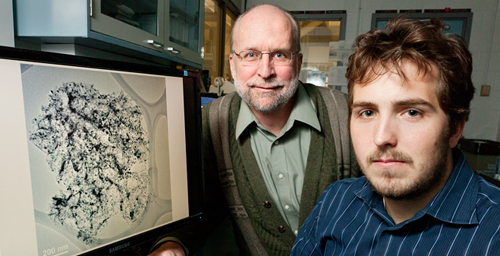Researchers from the University of Illinois have demonstrated a simpler method of attaching iron to tiny carbon spheres to obtain a catalytic material capable of removing pollutants found in gas or liquid

Researchers from the University of Illinois have demonstrated a simpler method of attaching iron to tiny carbon spheres to obtain a catalytic material capable of removing pollutants found in gas or liquid.
A carbon structure can be used as a support substrate for catalysts, such as iron and other metals. Iron is a relatively cheap and readily available catalyst with possible catalytic applications in the fields of fuel cells and the environment (adsorption of harmful chemicals, such as arsenic and carbon monoxide). Researchers from the University of Illinois were able to prepare a carbon substrate containing many nozzles or channels, similar to a sponge. The large surface area obtained as a result of the existence of these nozzles provides many sites for scattering tiny iron particles throughout the length and width of the substrate.
A common source of carbon is coal. Normally, scientists turn coal-based materials into highly porous activated carbon and then add a catalyst to it. This multi-step process takes a long time and requires a lot of energy investment. In addition, coal-derived materials may be contaminated with ash, which in turn may contain residues of other metals that impair the catalytic activity of the final material. The researchers' innovative process, which is cheap and without coal ash, makes it possible to obtain carbon from sugar rather than from coal.
In a continuous process and in one step, tiny, micron spheres of porous, sponge-like carbon embedded in iron nanoparticles are obtained - all within a few seconds.
"This is the essential characteristic that distinguishes our method from other methods. Some scientists managed to combine carbon and iron, but the resulting surface area was small. Other scientists were able to get a large surface area, but were unable to attach iron to them," explains the lead researcher. "Our method provides both the extensive carbon surface and the iron nanoparticles in one process."
The researchers relied on a method called "ultrasonic spray pyrolysis" (ultrasonic spray pyrolysis, USP), which was developed back in 2005 at the University of Illinois in the laboratory of chemistry professor Kenneth Suslick. This researcher used a home humidifier to obtain tiny vapors of a high-carbon solution, which he passed through a very hot furnace, which caused the water to evaporate from every drop and the creation of extremely porous tiny carbon spheres.
The researcher Atkinson used this method to prepare the carbon pellets, and together with it he added iron-containing salt to a high-carbon sugar solution. When the stream of steam is introduced into the furnace, the high heat inside encourages the occurrence of a chemical reaction between the components of the solution that form the carbon globules and the iron particles dispersed in it. "We took advantage of the USP method and simultaneously incorporated into it the introduction of metal nanoparticles into the porous carbon," explains the lead researcher. "The method is simple because it is continuous. We are able to isolate the carbonaceous material, add pores to it and inject iron into it in one step."
Another advantage of this method lies in its ability to produce materials with special applications and defined requirements. By creating a new material from scratch, rather than through the controlled modification of ready-made products, scientists and engineers are able to develop materials to address specific problems.
"Nowadays, you can mine coal from the earth's condensate and change it. But, it is quite difficult to turn it into a material that will provide an answer to a specific air quality problem," explains the researcher. On the other hand, with our method, it is easy to change the material and adjust its activity to required requirements by changing its surface area and the amount of added iron. Our method is simple, flexible and adapted to the required need."
In the next step, the research team will examine the possible applications of this method. They are already trying to develop high-carbon pellets that will be used to remove nitrogen oxide, mercury and dioxin from gas emissions - three pollutants dangerous to human health that originate from the emissions of combustion units.
Currently, these three pollutants are treated separately using carbon-based adsorbents and catalysts, but the research team hopes to utilize the adsorption capabilities of the carbon pellets and the reactivity of the iron to remove all three of these pollutants from the emissions stream at the same time.
"We are trying to take advantage of the advantages of these materials, both in terms of being porous and in terms of being catalytic," explains the lead researcher. "Carbon is a very versatile and flexible material. In my mind's eye, I see the possibility of using this method for the development of a control mechanism for several pollutants at the same time that will utilize the property of porosity and the property of catalysis to deal with both problems in one step."
The news about the study
